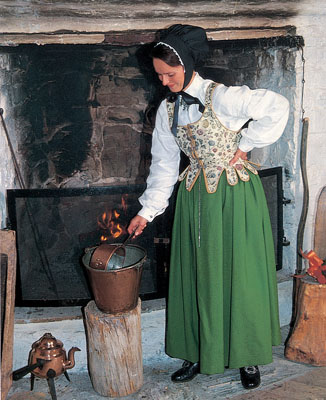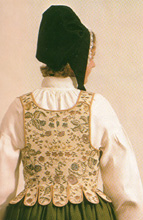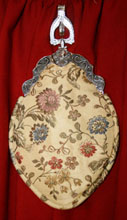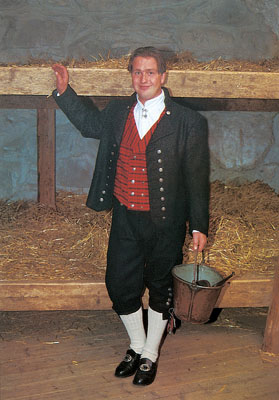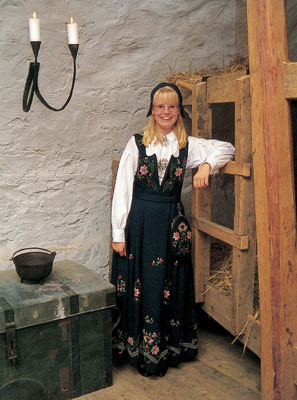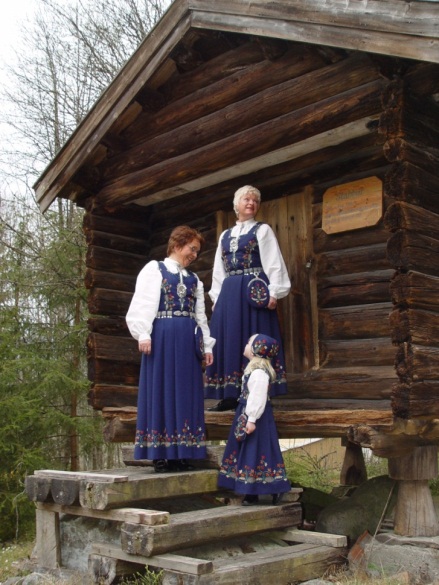Female “bunad” from Solør-Odal
After extensive research the Solør-Odal “bunad” (traditional folk costume) for women was reconstructed and approved by ““landsnemnda for bunadspørsmål”” in 1958.
The “bunad” is built around a bodice from Solør arising in the 1700s. It is now at “Glomdalsmuseet”. The embroidery on the shirt comes from a wedding shirt from the same time era. The inspiration to the wrinkle bonnet is also at Glomdalsmuseet – a bonnet type that was common in the district at that time. The Bodice is flourishing brocade with black, red or beige life. It has batches joints, which are closed at the front with a silver chain strung through silver eyelets. For the skirt, with a plain front piece, four different colors is possible: black, blue, green or rust red. The shirt is made of linen with embroidered stitching and wire tags on the neck and hand waistbands.
Pictures from left:
1. The wrinkle bonnet in black silk.
2. The brocade bodice from the 1700 year hundred.
3. The decorative bag with a brass claps from the 1700 year hundred
The wrinkle bonnet is in black silk. It has puckered pull and smooth forehead piece edged with a white lace along the front edge. It has ties that can hang loosely down. As outerwear a black hand-woven wool shawl with fringe is used. Black stockings and “bunad” shoes complete the costume.
The silver to the Solør Odal “bunad” consists of silver eyelets which together with the long silver rope belongs to the bodice, a brooch and cuff buttons. All designed according to old silver traditions from the district. Lately this are complemented with finger ring and earrings.
The decorative bag has been added to the costume after year 2000, the model is derived from an old bag from Odal. The bag design is based on a brass clasp from the 1700 year hundred, a brocade front and a leather back piece. The brocade front is normally adapted to the bodice brocade.
Male costume (“Mannsbunad”) from Solør-Odal
The “mannsbunad” was developed in the late 1950’s mainly by Klara Semb. The pattern is replicated by breeches and a jersey from Solør, which is currently in the Norwegian Folk Museum. The “mannsbunad” for Solør-Odal has many similarities with Østerdal “mannsbunad”. So it is then also said that in the past it was difficult to distinguish the men from the Østerdal and Solør.
The jacket / breeches are made of densely packed black homespun. The jacket is double-breasted with a row of pewter buttons on each side while the breeches have flaps that are buttoned up at the waistband with three buttons. It also has bands and pewter buttons at the knee. The vest is without collar, made from hand woven wool with red and black checkered pattern, the lapels are folded down, and it is double-breasted with pewter buttons. The shirt is in white cotton canvas with embroidered scalloped lines along the neck and hand wrists. It uses double neck button in silver with links and cross-shaped leaves and cufflinks with engraved pattern. The cap is a black shield cap. White hand knitted woolen stockings, fingering hose bands in multiple colors, and black “bunad” shoes completes the costume.
Lundeby costume
Art painter Alf Lundeby (1870 -1961) from Tøråsen in Våler Solør composed this in the same style as most costumes from this era. It was finished in 1932, and he gave the first to his girlfriend, on her 50th birthday. At that time he lived in Lillehammer, hence many feel that the costume also has associations to Oppland fylke.The costume is available in black, blue or white wool fabrics. It has embroidery in beautiful color combinations The costume have a plain design with a mounted skirt with folding’s, this allows for some flexibility in body shape.
Outerwear is a short jacket with wide sleeves in the same fabric as the costume. It can be closed in the front with four pewter clasps. The jacket has no embroidery. The shirt is a simple cotton shirt with tatting on the collar and the hand wrists. The white costume is accompanied with an ecru colored shirt in natural silk with tatting in the same color. The silver to Lunderby costume consists of three brooches in different sizes. It does not mean that you must choose between three brooches for one costume, but choose two of three possible. The bag clasp and the cufflinks is a part of the silver package, made from Norwegian silversmith art. The raw material is of the best Nordic quality. The bag is embroidered with the same embroidery as the costume with a silver-plated bag clasp. A small bonnet, without chin straps, but with embroidery, is the headdress to Lundeby costume.
More information with respect on the “bunad”s above can be obtained from:
http://www.tante-marie.no/ mail post@tante-marie.no
The female embroidered “bunad” from Solør-Odal
The embroidered “bunad” was developed in the 1930’s, of a committee with members from Kongsvinger Omegns Handicrafts Association. The bases for the design should be old clothing from the district; however it was never the intention to do an exact copy. The work was carried out according to Hulda Garborgs principles: The goal was an old stylish “bunad” with a local identity based on the old outfits. The design was completed in the summer 1940, however due to the war it lasts until 1946 before any significant production started. At that time the “bunad” consisted of a evening gown with embroidery, a shirt and a loose purse. A cap, a cape, a short jacket and silver have been added later.
The “bunad”s embroidery is taken from a silk cap from Solør. The original has silk embroidery on silk fabric, but is added to the “bunad” as wool embroidery on wool. The pattern is characterized by rococo style, with stylistic floral and lattice patterns. After the design was transferred to the costume, some argued that the pattern represents heater flowers and cones and symbolizes forest districts in Solør – Odal.
More information with respect on the “bunad” above can be obtained from:
Beau Sy., Parken Shopping Mall, 2100 Skarnes
Phone: +4762961483
mail Kass@east.no


